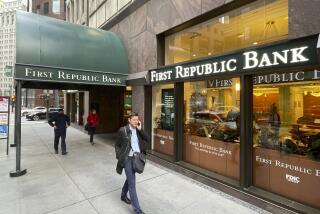Fed, as Expected, Allows Banks to Buy Healthy S
- Share via
WASHINGTON — The Federal Reserve Board voted Thursday to permit bank holding companies to buy healthy thrift institutions, a decision expected to accelerate the shrinkage of the savings industry and the expansion of interstate banking.
The 6-0 vote culminated a bitter, two-year struggle among financial industry groups seeking to influence the central bank’s ruling.
But it is also something of an anticlimax because S&L; bailout legislation signed into law two weeks ago authorized the Fed to make the decision and members of Congress clearly expected that it would.
Under the federal regulatory scheme, banks and savings associations were kept strictly separate until 1982, when Congress decided to allow bank holding companies to purchase ailing thrift institutions.
In September, 1987, the Fed proposed opening up all thrifts to purchase by banks but delayed its decision after it ran into a barrage of criticism from S&Ls;, small banks and members of Congress.
“I support” the change, said board member Martha R. Seger. “I’m just sorry it took us two years to do it.”
When the Bush Administration originally proposed its S&L; bill six months ago, it had called for a two-year delay before banks could buy healthy S&Ls; on the theory that banks wouldn’t want to buy ailing thrifts if they had the chance to purchase sound institutions.
$30 Billion Needed
But Congress scrapped the waiting period in an effort to entice banks into investing in marginal, but still solvent, savings associations.
Earlier this week, James R. Barth, chief economist of the Office of Thrift Supervision, said solvent S&Ls; will have to raise $30 billion to meet new capital requirements going into effect year-end.
He estimated that half of the approximately 2,600 solvent S&Ls; in the nation, representing 85% of the industry’s assets, fall short of the new standard.
Many savings institutions, which had been skeptical of the change as a threat to their independence, now welcome it because it increases the potential buyers, and price, of their stock.
“The healthy institutions are happy to have more people interested in their stock,” said Dennis J. Jacobe, research director of the U.S. League of Savings Institutions.
Earlier, the league and small banks warned that thrifts owned by banks would de-emphasize home mortgage lending and eventually convert to banks.
“This just adds another nail to the coffin . . . of a separate thrift industry,” said Diane Casey, director of regulatory affairs for the Independent Bankers Assn. of America, which represents community banks.
The independent bankers also complain that the decision is a backdoor method of allowing large firms like Citicorp, the nation’s largest banking company, to circumvent state laws that protect their banks from out-of-state buyers.
More to Read
Inside the business of entertainment
The Wide Shot brings you news, analysis and insights on everything from streaming wars to production — and what it all means for the future.
You may occasionally receive promotional content from the Los Angeles Times.










